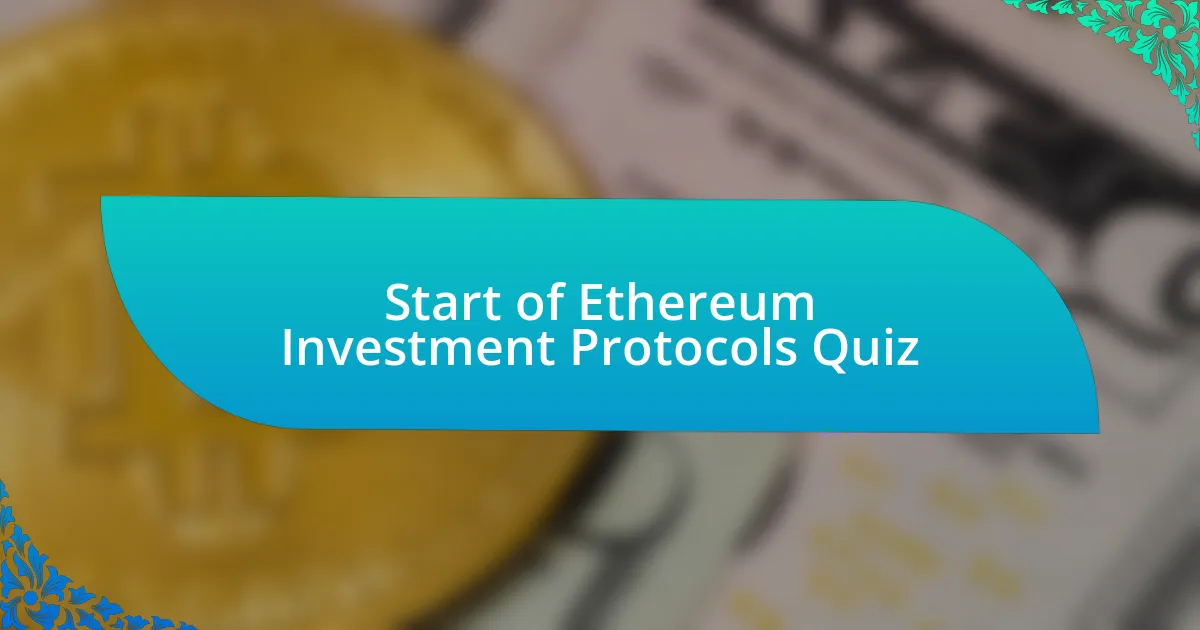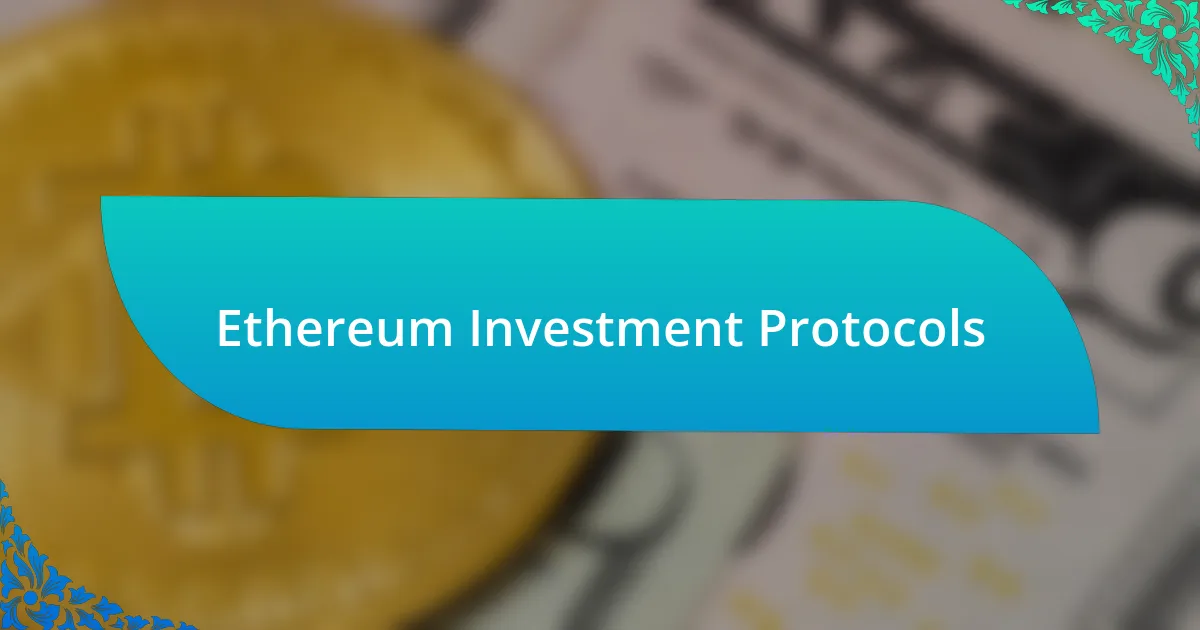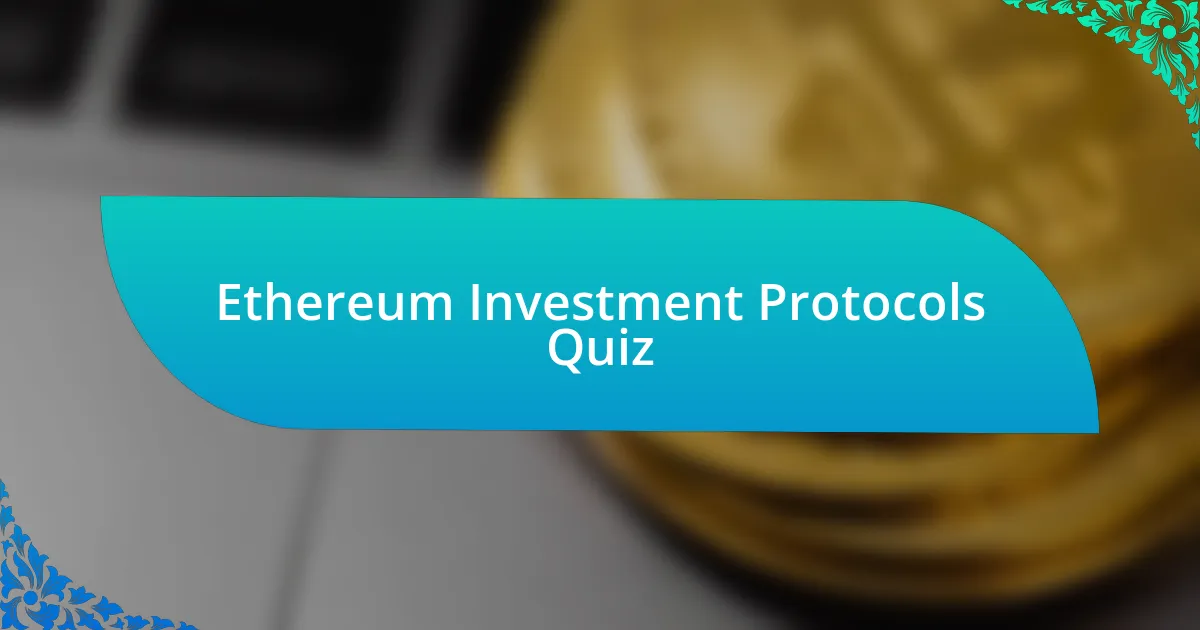
Start of Ethereum Investment Protocols Quiz
1. What is the primary purpose of Ethereum as a financial application?
- To issue government currencies.
- To facilitate decentralized applications.
- To provide online banking services.
- To manage stock trading.
2. How do financial applications leverage Ethereum smart contracts?
- Financial applications utilize Ethereum smart contracts to automate transactions and enforce agreements without intermediaries.
- Financial applications leverage Ethereum smart contracts to issue traditional bank loans and mortgages.
- Financial applications use Ethereum smart contracts solely for data storage and retrieval purposes.
- Financial applications depend on centralized servers to manage transactions and agreements.
3. What feature of Ethereum enhances the security of financial transactions?
- Federated Byzantine Agreement
- Proof-of-Stake
- Proof-of-Work
- Delegated Proof-of-Stake
4. What is the significance of the ERC-20 token standard in Ethereum finance?
- It increases the mining reward for Ethereum miners.
- It protects the Ethereum network from cyber attacks.
- It allows for the creation of standardized tokens on the Ethereum blockchain.
- It speeds up the transaction processing times for Ether.
5. How do decentralized finance (DeFi) applications utilize Ethereum?
- They require centralized servers to operate.
- They focus solely on creating non-fungible tokens (NFTs).
- They build applications that enable users to lend, borrow, and trade assets.
- They only serve as payment processors for transactions.
6. What is yield farming in the context of Ethereum?
- Yield farming is a trading strategy that focuses on day trading stocks on the stock market.
- Yield farming is when users store their cryptocurrencies in cold wallets for security.
- Yield farming is a method to mine new cryptocurrencies using traditional mining rigs.
- Yield farming is a process where users provide liquidity to decentralized finance (DeFi) platforms in exchange for rewards.
7. How does liquidity provision work in Ethereum-based protocols?
- Liquidity is established through centralized authority control over transactions.
- Liquidity is provided by users who deposit tokens into liquidity pools for trading.
- Liquidity is achieved by burning all unused tokens permanently.
- Liquidity is created by generating non-fungible tokens (NFTs) exclusively.
8. What role do stablecoins play in Ethereum financial applications?
- Stablecoins provide a stable base currency for trading in Ethereum financial applications.
- Stablecoins are used exclusively for mining on the Ethereum network.
- Stablecoins create unpredictable volatility for Ethereum trades.
- Stablecoins have no role in Ethereum financial applications.
9. How can individuals earn passive income through Ethereum finance?
- By creating a social media account on Ethereum.
- By buying stocks of Ethereum companies.
- By mining new Ether with a computer.
- By staking Ether to participate in the network.
10. What is a decentralized exchange (DEX) and how does it work on Ethereum?
- A decentralized exchange (DEX) requires users to deposit their assets into a central wallet before trading.
- A decentralized exchange (DEX) only facilitates fiat currency trades and does not support cryptocurrency transactions.
- A decentralized exchange (DEX) is a platform where trades are managed exclusively by a centralized authority.
- A decentralized exchange (DEX) allows users to trade cryptocurrencies directly without a central authority, using smart contracts on Ethereum.
11. How does Ethereum facilitate peer-to-peer lending?
- Ethereum uses blockchain to create physical lending contracts and paperwork.
- Ethereum allows users to lend directly to lenders via traditional methods.
- Ethereum uses smart contracts to automate lending agreements between users.
- Ethereum facilitates lending through centralized banks that manage funds.
12. What is the impact of Ethereum gas fees on investment protocols?
- Gas fees only impact the speed of transactions and not investments.
- Low gas fees always increase investment opportunities.
- High gas fees can deter investment in decentralized applications.
- Gas fees have no effect on investment in Ethereum.
13. How does margin trading occur within Ethereum ecosystems?
- Margin trading in Ethereum occurs through decentralized exchanges using smart contracts.
- Margin trading in Ethereum happens exclusively on Bitcoin networks.
- Margin trading is a process that involves offline trading with physical assets.
- Margin trading is managed solely by centralized banks via traditional methods.
14. What is the importance of collateralization in Ethereum loans?
- It allows for unrestricted borrowing, increasing the loan amount.
- It encourages borrowers to take more risks without consequences.
- It ensures that loans are secured, reducing the risk for lenders.
- It prevents any interest from accruing on the loan.
15. How do token swaps function in the Ethereum network?
- Token swaps are limited to trading only Ether against Bitcoin on a centralized exchange.
- Token swaps involve converting tokens into fiat currency before any exchanges can occur.
- Token swaps allow users to exchange one cryptocurrency for another through decentralized protocols.
- Token swaps require users to send their tokens to a centralized broker for swapping them.
16. What are the benefits of staking Ether in Ethereum financial applications?
- Earning rewards and participating in network security
- Creating new tokens without limits
- Guaranteeing transaction anonymity
- Holding Ether for trading purposes
17. What is a liquidity pool and how does it relate to Ethereum?
- A liquidity pool is a collection of assets locked in a smart contract on Ethereum that facilitates trading by providing liquidity for decentralized exchanges.
- A liquidity pool is a database that stores all Ethereum transactions for auditing purposes.
- A liquidity pool is a financial instrument used exclusively for issuing new Ether tokens.
- A liquidity pool is a type of investment account that secures funds for stock trading on centralized exchanges.
18. How do Ethereum-based insurance protocols operate?
- Ethereum-based insurance protocols use smart contracts to automate claims processing and payouts.
- Ethereum-based insurance protocols rely on traditional brokers to handle claims manually.
- Ethereum-based insurance protocols require users to submit claims through a central authority for approval.
- Ethereum-based insurance protocols only cover cryptocurrency transactions, not real-world events.
19. What is flash lending and how is it used on Ethereum?
- Flash lending is a service that enables trading Ethereum assets at a fixed interest rate over a period of time.
- Flash lending is a method to earn interest on Ethereum assets by holding them in a wallet for a short time.
- Flash lending is a tool to create new tokens on Ethereum by locking existing tokens as collateral.
- Flash lending allows users to borrow funds instantly on Ethereum without upfront collateral, requiring repayment within the same transaction.
20. How do governance tokens function in Ethereum financial applications?
- Governance tokens function as a store of value for crypto assets.
- Governance tokens give holders voting rights on network protocols.
- Governance tokens provide privacy for transaction details on the blockchain.
- Governance tokens are used solely for trading on exchanges.
21. What are the risks associated with investing in Ethereum’s DeFi projects?
- DeFi projects are guaranteed to generate high returns.
- Smart contract bugs and exploits are common risks.
- Ethereum transactions are irreversible and free.
- All Ethereum DeFi projects are fully regulated by the government.
22. How does Ethereum’s scalability upgrade impact investment protocols?
- Ethereum’s scalability upgrade has no effect on investment protocols, as they operate independently.
- Ethereum’s scalability upgrade increases the minimum investment requirements for all protocols.
- Ethereum’s scalability upgrade reduces gas fees and increases transaction speeds, enhancing investment protocols.
- Ethereum’s scalability upgrade only benefits NFT creators, leaving investment protocols unchanged.
23. What is an automated market maker (AMM) in Ethereum finance?
- An automated market maker (AMM) is a protocol that facilitates trading by using algorithms to set prices and manage liquidity in decentralized finance.
- An automated market maker (AMM) is a type of digital wallet that stores cryptocurrencies securely.
- An automated market maker (AMM) is a framework for developing traditional finance applications on blockchain.
- An automated market maker (AMM) is a voting mechanism used in decentralized governance of blockchain projects.
24. How does crypto arbitrage function utilizing Ethereum?
- Crypto arbitrage relies on Ethereum to create decentralized games for users to play and earn rewards.
- Crypto arbitrage employs Ethereum to generate new tokens by mining them in batches.
- Crypto arbitrage utilizes Ethereum to exploit price differences across exchanges by buying low on one and selling high on another.
- Crypto arbitrage depends on Ethereum to lend users funds at a fixed interest rate for investments.
25. What are Ethereum forks, and how do they affect financial applications?
- Ethereum forks are updates to the user interface of dApps that streamline user experiences without altering their functionality.
- Ethereum forks are just marketing strategies used by developers to promote their dApps without any real impact on the Ethereum network.
- Ethereum forks occur when the blockchain is split, creating two distinct versions of network software that can impact applications by creating incompatibilities or new functionalities.
- Ethereum forks are social gatherings where developers discuss new features for the platform that don`t affect financial applications.
26. How do oracle services enhance Ethereum’s financial applications?
- Oracles create new tokens to fund Ethereum projects.
- Oracles validate transaction details to ensure accuracy in the blockchain.
- Oracles increase the speed of block confirmations in Ethereum.
- Oracles provide external data to enable informed decisions in smart contracts.
27. What is the role of DAOs in Ethereum financial governance?
- DAOs remove all forms of governance from Ethereum networks.
- DAOs are primarily for data storage without governance roles in Ethereum.
- DAOs limit the governance to a single authority over Ethereum.
- DAOs enable decentralized decision-making and functions in Ethereum governance.
28. How does Ethereum facilitate tokenization of real-world assets?
- Ethereum employs a centralized database for asset management.
- Ethereum requires physical paperwork for asset tokenization.
- Ethereum allows peer-to-peer sharing of cryptocurrencies.
- Ethereum uses smart contracts to create unique tokens on its blockchain.
29. What trends are shaping the future of Ethereum investment applications?
- Switching to a proprietary blockchain will limit access to developers.
- The transition to Proof-of-Stake enhances Ethereum`s scalability and efficiency.
- Increasing block size allows for more transactions per second.
- Launching centralized exchanges will boost Ethereum`s adoption.
30. How do gas price fluctuations affect Ethereum-based financial services?
- Gas prices only affect Ethereum mining operations, not financial services.
- Gas price fluctuations have no impact on Ethereum-based financial services.
- Ethereum-based financial services may become less accessible due to increased gas fees.
- Ethereum-based financial services benefit from higher gas prices because they indicate network popularity.

Quiz Successfully Completed!
Congratulations on completing the quiz on Ethereum Investment Protocols! You’ve taken an important step in enhancing your knowledge of this dynamic and evolving topic. Throughout the quiz, you explored various aspects of Ethereum, including its unique investment opportunities, decentralized finance (DeFi) protocols, and risk management strategies. Each question aimed to deepen your understanding of how Ethereum operates as both a technology and an investment vehicle.
As you reflect on what you’ve learned, consider how this knowledge can influence your investment decisions. Understanding the fundamentals of Ethereum and its protocols gives you an edge in recognizing potential investment opportunities. You may have discovered insights into how to assess the risks and rewards associated with Ethereum-based investments, which is crucial in today’s fast-paced market.
We invite you to continue your learning journey! Check out the next section on this page, where we provide more in-depth information about Ethereum Investment Protocols. This resource will help you further expand your understanding and keep you updated on the latest trends and strategies in the Ethereum space. Happy learning!

Ethereum Investment Protocols
Understanding Ethereum Investment Protocols
Ethereum investment protocols refer to the frameworks and standards that allow users to invest in Ethereum-based assets. These protocols facilitate various financial operations, such as trading, lending, and yield farming on the Ethereum blockchain. They leverage smart contracts to automate transactions, enhance security, and improve transparency. Popular examples include Uniswap for decentralized trading and Aave for lending. The growth of these protocols showcases the evolving landscape of decentralized finance (DeFi).
Major Types of Ethereum Investment Protocols
There are several categories of Ethereum investment protocols, each serving specific purposes. Decentralized exchanges like Uniswap enable users to trade tokens without intermediaries. Lending protocols, such as Aave and Compound, allow users to borrow and lend assets. Yield farming protocols, including Yearn.finance, let users earn returns on their investments. Additionally, staking protocols enable users to participate in network validation while earning rewards. These varied types highlight the versatility of Ethereum investment protocols.
How Smart Contracts Enable Ethereum Investment Protocols
Smart contracts are self-executing contracts with the terms of the agreement directly written into code. They are a foundational technology behind Ethereum investment protocols. Smart contracts automate the execution of transactions, ensuring that all parties meet their obligations. This automation reduces the need for intermediaries and mitigates risks associated with human error. The reliability of smart contracts enhances the efficiency of trading and investing on the Ethereum platform.
Risks Associated with Ethereum Investment Protocols
Investing in Ethereum protocols carries inherent risks. Smart contract vulnerabilities can lead to exploits, resulting in financial loss for users. Market volatility in cryptocurrencies can significantly impact investment value, leading to sudden and substantial losses. Regulatory uncertainty also poses a risk, as changing laws can affect the operation of these protocols. Investors must conduct thorough research and consider their risk tolerance when engaging with Ethereum investment protocols.
The Future of Ethereum Investment Protocols
The future of Ethereum investment protocols is poised for growth and innovation. Developments such as Ethereum 2.0 aim to improve scalability and reduce gas fees, enhancing user experience. New protocols and projects are continually emerging, focusing on niche areas within the DeFi space. Increased institutional interest may drive further adoption and establish Ethereum protocols as mainstream investment options. As the ecosystem matures, it is likely to become more secure, user-friendly, and diversified.
What are Ethereum Investment Protocols?
Ethereum Investment Protocols are decentralized finance (DeFi) platforms built on the Ethereum blockchain. They facilitate various investment activities like lending, borrowing, and yield farming. These protocols utilize smart contracts to automate financial transactions, ensuring transparency and security. For instance, protocols like Aave and Compound allow users to earn interest on their crypto holdings by lending them to others.
How do Ethereum Investment Protocols work?
Ethereum Investment Protocols operate using smart contracts, which automatically execute transactions when predefined conditions are met. Users deposit their assets into the protocol, which then pools these assets to provide liquidity for lending or trading. The protocol calculates interest rates based on supply and demand. For example, in Compound, user deposits earn interest that is paid by borrowers, reflecting real-time market dynamics.
Where can you find Ethereum Investment Protocols?
Ethereum Investment Protocols can be accessed through decentralized exchanges and platforms like Uniswap, Aave, and Compound. These platforms are available on the Ethereum network and can be used via compatible wallets such as MetaMask. Users can explore various protocols through aggregators like DeFi Pulse, which list and rank them based on metrics like total value locked (TVL).
When were Ethereum Investment Protocols developed?
Ethereum Investment Protocols began to gain prominence in 2020 during the DeFi boom. This period saw the emergence of several protocols like Compound and Aave, which popularized decentralized lending and borrowing. The total value locked in DeFi applications increased from $700 million in January 2020 to over $10 billion by September 2020, highlighting the rapid development and adoption of these investment protocols.
Who created Ethereum Investment Protocols?
Ethereum Investment Protocols are developed by various independent teams and organizations within the blockchain community. For instance, Compound was created by Compound Labs, led by Robert Leshner, while Aave was initiated by Stani Kulechov. These creators leverage Ethereum’s technology to enhance financial inclusiveness and innovation in investment opportunities.

